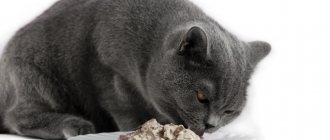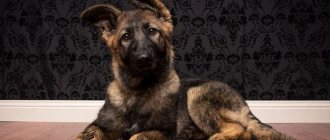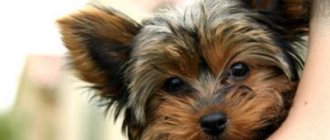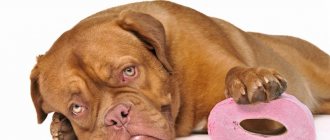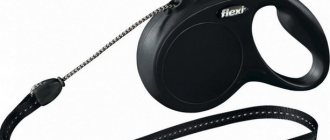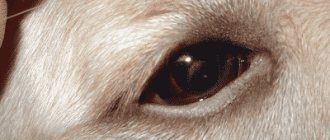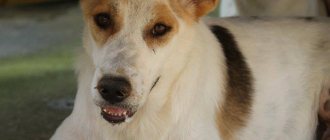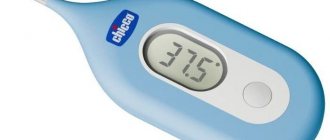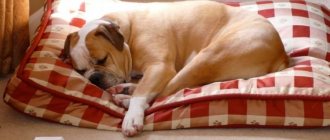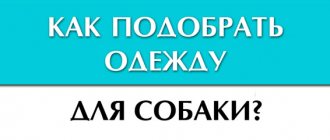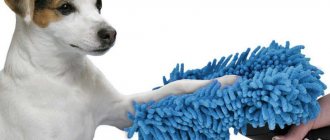Causes of excess weight in dogs
Experts identify several reasons why a dog may develop obesity.
Note! In many cases, excess weight occurs due to the fault of the owner.
Lack of movement
Dogs are active and mobile creatures. Any breed (small Spitz or large retriever) needs long walks. If an animal is taken outside only to relieve its natural needs, then very soon it will begin to gain excess weight.
Excess weight is dangerous for a dog and can lead to the development of many problems.
Poor nutrition
The pet must have a diet. It is recommended to carefully select the appropriate food. If your diet is natural, you should pay attention to good foods with low fat content. In addition, you cannot feed your dog constantly and give it food from the table.
Important! Many owners are touched when the dog happily eats everything and constantly asks for more. However, the animal gradually gains excess weight from overeating.
Sterilization and castration
After such interventions, the animal’s sexual instinct is suppressed, so the dog can direct all its energy to searching for food. In addition, surgery can cause a slowdown in metabolism. Doctors recommend reviewing the diet of animals that have undergone castration or sterilization.
Hormonal disorders
Malfunctions in the hormonal system also lead to a slowdown in metabolism, which can also cause obesity.
For your information! There are also dog breeds that are prone to obesity - pugs, basset hounds. For such pets, it is important to immediately develop a suitable diet.
It is important to choose the right diet for the animal
Possible health effects
How much dry food to give a dog per day: table
Obesity in animals, as in humans, often causes serious problems in the body. For dogs, excess weight threatens the following pathologies:
- diabetes;
- heart and vascular diseases;
- liver and kidney diseases;
- disruption of the digestive system;
- increased risk of developing problems with the respiratory system;
- hormonal and endocrine disruptions;
- skin problems;
- visual impairment.
In addition, overweight dogs often suffer from sprains, joint and bone diseases, spinal dysfunction, and hip and shoulder dysplasia.
Diet for Yorkies for weight loss
An important condition for keeping dogs of any breed is choosing the right, balanced and nutritious diet. The development, growth, and health of the dog depend on a properly formulated diet. It is equally important to determine the volume of portions and calculate the calorie content of the animal’s diet. However, quite often owners make mistakes in feeding their pets, which in turn leads to various disruptions in the functioning of the digestive and endocrine systems. Most often, an unbalanced diet, overfeeding and foods from our table, which are forbidden delicacies for dogs, cause metabolic disorders and obesity. Excess weight in dogs can lead to many health problems.
Causes of excess weight in Yorkshire terriers
There is a common belief that the Yorkshire Terrier breed is quite picky and picky when it comes to food, but this is absolutely not true. Yorkies are big food lovers, and despite their small size, even after their meal they can ask for more with hungry eyes. If a dog is picky about food, it’s the owners’ fault. In addition, some Yorkies simply have an excellent appetite! Of course, it is so difficult to refuse the cute pleading eyes of a pet, and in the intervals between main meals, owners, making one of the most common mistakes, begin to feed their pet with treats.
In addition, Yorkie owners choose this breed because it does not require long walks. Of course, the Yorkshire terrier is not a German shepherd, boxer, poodle, or husky, which vitally need daily long walks, but still, any dog should receive physical activity, regardless of its breed. If dogs move little, walk and turn into “apartment” pets, but at the same time they receive a nutritious, high-calorie diet in which its energy value exceeds the body’s costs, problems with excess weight appear.
How to find out your ideal weight
Fetch (command) for a dog: what it means, how to teach it
The weight of a dog depends on the breed and size. However, sometimes the weight is within the normal range, but the dog is still diagnosed with obesity. To accurately assess your pet’s condition, experts suggest using the following data:
- if your pet’s ribs, bones and spine are clearly visible even from a distance, this indicates a lack of required mass and a deficiency of fat deposits;
- when palpated and examined, the ribs and spine are easily identified, and when viewed from above, a well-defined waist and a tucked belly are noticeable, then we can say that the animal’s weight is below normal;
- upon palpation, the ribs are easily identified, but are not visible, the waist is visible, the stomach is tucked up and not sagging - this is the ideal condition of the pet, the weight in this case is considered normal;
- The ribs and spine are difficult to feel through the layer of fat. When viewed from above, the waist is wide; when viewed from the side, a sagging belly is noticeable. Types of fat deposits on the chest, hips, and tail. This condition indicates that the pet is overweight;
- the presence of significant deposits of fat on the chest, back, at the base of the tail, a heavily sagging stomach, lack of a waist, a wide chest and stomach - such signs indicate obesity.
Note! The ideal weight is calculated by the veterinarian for each dog individually, depending on its characteristics.
The animal must be weighed every week to note changes in weight.
Making a weight loss plan
Before putting your dog on a diet, it is recommended to develop a weight loss plan. At the initial stage, it is recommended to consult a specialist. The veterinarian will conduct the necessary examinations of the animal and clarify exactly how much the animal needs to lose.
How to brush your dog's teeth at home
An experienced doctor will help you create a diet for the animal, check your pet for any diseases, and recommend the most suitable food.
Important! There are currently medications available to help dogs lose weight. However, such drugs are used only with the permission of a veterinarian and only when absolutely necessary.
Before putting your dog on a diet, it is recommended to create a table in which you enter daily data on food, duration of walks, and weight of the pet.
Nuances of losing weight for different breeds
Large dogs should be fed three times a day, small pets - 4. Older pets should be fed once a day - this reduces the load on the pancreas.
If your Dachshund, Spitz or Yorkie needs to lose weight, a complete overhaul of their diet is required. Fatty foods, fish, and bread should be removed from the natural diet of large dogs (huskies, Labradors, etc.).
Attention! Traditional delicacies can be replaced with biscuits, apples, carrots, or use store-bought delicacies.
A diet for dogs with obesity is a necessity that will help prolong the pet’s life and maintain health. Studying information on how to lose weight for a dog, examination by a veterinarian, following recommendations regarding nutrition and maintenance are the basic rules for gradual and healthy weight loss.
Amount of food
It is important to accurately calculate the required amount of food. You cannot feed your dog constantly; there should be a limited number of meals per day and a calculated portion.
Veterinarians often recommend switching your pet to a special dietary dog food for weight loss. This option will allow you to be satisfied with a small amount of food, but this portion contains all the necessary vitamins and microelements.
For your information! Dietary lines exist from many manufacturers, for example, Monge, Hills, Royal Canin, No, but there are also other premium foods.
What should the diet be like?
“What to feed a dog to make it lose weight?” is a question many owners ask. The diet for dogs with obesity is selected together with a veterinarian. It is recommended to warn all relatives that the dog’s food is limited, and this condition must be adhered to.
A diet for a Chihuahua to lose weight will differ from the diet for large dogs, so you should be careful when choosing a diet.
Note! The animal should not starve, this will lead to negative consequences.
How to lose weight for a Labrador? Large breed dogs are fed 3 times a day, small dogs (Yorkies, Spitz) - 4 times. Older dogs are given food once a day to reduce the load on the pancreas and normalize metabolism, but it must fully cover the dog’s need for all necessary elements.
In order for a dachshund, Yorkshire terrier or other dog breed to lose excess weight, it is important to completely review the diet. If the dog is natural, then fatty meat and fish, baked goods and sweet products are removed. It is better to include more vegetables in your diet, and replace tasty treats with carrots, apples, biscuits and other low-calorie foods. There are many recipes for dietary dog food.
Important! If professional dry dog food for weight loss is chosen for the diet, then the specified dosage and number of feedings must be strictly observed.
Start losing weight
After such an unplanned feeding, your pet begins to become fat. This means that there is a heavy load on the heart and all joints. The dog himself may not notice this, but you should see that the dog no longer runs and frolics as before.
It’s better for your Labrador to lie at your feet and watch other dogs run around. Unfortunately, this situation is familiar to many owners of beautiful Labradors. Not all dog lovers know that excessive obesity can lead to the premature death of a dog.
Therefore, the question often arises about how to lose weight for a Labrador, which everyone loves and is afraid of losing. First of all, the owners should review his diet and, of course, gradually eliminate snacks between feedings.
It is worth starting gradually, since the dog’s body quickly gets used to feeding and if you remove the food immediately, the dog will become irritable, which can lead to stress. Replace all dog treats with vegetables or fruits at snack time. Of course, the Labrador will not like the treat, but he will eat because his stomach demands it.
Leave your regular diet the same - you don’t need to add anything to it. Every day you need to reduce the amount of vegetables you give between feedings until your dog stops snacking altogether.
Physical exercise
All dogs love walks and games. If at the initial stage it is difficult for the animal to move quickly, then it is necessary to at least increase the walking time. Active games and jogging are gradually added. Small breed dogs should be handled as little as possible so that they can move independently. You can take animals out into nature; the presence of new sounds and smells will interest the dog, and it will forget about laziness. There is no need to immediately try to force the dog to build muscles, it is important that he enjoys it.
Exercise is good for any animal
What not to do
There are a number of actions that are unacceptable while your pet is on a diet:
- You cannot limit your dog to water, it is dangerous for his body;
- It is necessary to initially collect all the information about treats, some products can be toxic to dogs;
- Excessive physical activity is also not always suitable for the animal. It is recommended not to strain your pet too much in the initial stages.
You cannot deprive your dog of food completely; the process of losing weight should be gradual.
How to properly treat obesity in dogs?
Throw a ball, puller, frisbee into the water. Take frequent walks along the stream bank and along the pebbles. The dog doesn’t like anything and just pulls on the leash. Rare luck!
In this article: How to reduce the calorie content of your dog's food? How to train a dog? If you notice that your dog is getting fatter, don't be too surprised. Many pet dogs gradually gain weight over an extended period of time. This may seem like a purely aesthetic problem, but obesity or weight gain means health problems for your pet, including additional stress on the joints, heart, lungs, and a reduction in life expectancy.
Buy or sew a comfortable riding harness and a good sling with a shock absorber, tie it to your belt. You can walk on the asphalt for a while, this will collect the pasterns well.
Practical advice from experts
Experts recommend monitoring your dog’s diet from childhood so that the pet develops normally. It is important to choose the right diet for the dog, regularly provide it with physical activity and in no case overfeed it.
Important! Giving goodies from the table is also wrong; it is better to buy special products that contain little sugar but more fiber.
If your dog is overweight, it is recommended to consult a veterinarian to develop an appropriate menu. We should not forget about physical activity and walks, which will help you lose weight faster. Excess weight can cause many diseases and problems in the body, so it is important to monitor the condition of your pet.
Feeding a Labrador
This breed is famous for its very good appetite. Labics not only love to eat, they simply cannot be pulled away from food and food supplies. This is why it is important to feed your dog in moderation to prevent it from gaining excess weight.
You can choose for your diet:
- ready-made food (canned or dry);
- natural products.
The first option significantly saves the owner’s time, while the second will help reduce food costs, especially for rural residents who have their own food grown.
The owners themselves make their own choice regarding feeding options. You just can’t change it or mix different options.
If you buy food in a store, it is better to choose super premium products. These foods have a balanced composition necessary for the full development of the dog.
A natural food diet should include:
- meat - 50% (single dose - 20 g per 1 kg of dog weight);
- porridge - 25% of the daily diet;
- vegetables - 25%.
You can give dogs fermented milk products. Veterinarians advise adding vitamin complexes with lutein, taurine, calcium, tocopherol and ascorbic acid to food.
Never offer to pets:
- grilled meat;
- smoked products;
- barley groats.
It is necessary to ensure that the dog does not feast on leftover food from garbage bins while walking. Labs are prone to obesity, so nutrition should be strictly controlled.
